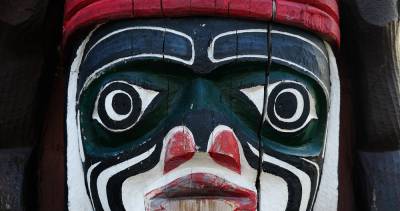Zvizdal (Chernobyl—so far so close) uses art and film to take you deep inside a radiation zone
A PuSh International Performing Arts Festival presentation. At the Roundhouse Community Arts and Recreation Centre on Thursday, January 31. Continues until February 2
Using projected film, live-edited music, and meticulously created miniature art installations, Antwerp-based collective BERLIN takes you right into a remote corner of the Chernobyl Exclusion Zone. And it's a mesmerizing, deeply moving trip.
The exclusion zone is the 2,600-square-kilometre area surrounding the site of the 1986 Chernobyl nuclear-plant disaster. People were evacuated because it's considered too toxic for human habitation. But down overgrown dirt roads, in a ramshackle homestead, live octagenarians Nadia and Pétro. For three decades, they have survived here without phones, electricity, or running water. As their gnarled, callused hands attest, they survive by hand-milking their cow and farming their land with a small scythe.
Working with journalist Cathy Blisson, the BERLIN team spent five years travelling in, sometimes through snow and downed trees, to interview the couple on camera.
The resulting "documentary installation" becomes much more than a passive film experience, falling closer to an artful and intimate meditation on the passage of time, on solitude and companionship, and on mortality itself.
On a formal level, what's most fascinating is the way BERLIN is able to tell this multifaceted story by playing its cutting-edge technology off both the handmade elements and the themes of nature slowly taking back the land. The audience sits in a galley, on stadium seating on either side of the central projection screen. Beneath that screen sit three circular models of the homestead—identical except for its season. One features lush green summer overgrowth, another the leafless trees of autumn, and the third a blanket of snow.
A dual, remote-operated camera tracks over these maquettes during the show, while two directors sitting at computers edit those closeup shots with the real footage on-screen. At the same time, the pair can activate the miniature sets to rotate on command. There's something about the way those models slowly circle and the way the dual camera passes over them that emphasizes the slow cycle of seasons, and the slow march of days, months, and years. The haunting soundtrack, from its electronic rhythms to pensive guitar, adds to the dreamlike feel.
Of course, the subjects themselves are equally captivating. It's almost impossible to believe that Nadia and Pétro have managed to survive here—until you get to know them. Nadia, so lame she can barely walk, is as adept at farm labour as her husband. He has a boyishness that belies his years—until late in the film, when both start, visibly, to decline. They still tease each other regularly—on several occasions, he jokes about finding a younger woman. As if there is one for miles.
Once a year, on Ukraine's day of lost souls, their former neighbours return to their relatives' gravesites in the region, and it's revealing to watch the old couple wait by the road to talk to them all.
If they crave communication that much, why have they so stubbornly insisted upon living in this ghost town for decades? You'll find yourself panicking, as the filmmakers seem to, each time winter rolls around—a season that brutally buries the beat-up home and barns. On one hand, their self-imposed exile seems insane, but there's a certain dignity and independence to what they're doing—a refusal to hand over any responsibility for their survival, even to their own daughter who left years ago. And the land, sometimes shot meditatively from the sky, is bucolic—the radiation that poisons it invisible to the eye.
Despite their driving hope, there is an inescapable sadness that envelopes everything here, from the fact that so many homesteads like this were destroyed in the nuclear catastrophe, to the grinding poverty and isolation.
On the other hand, you'll be surprised how much you learn from Nadia and Pétro's attitude to life. “This is how it is,” they say. "What makes you think the grass is greener somewhere else? It is the same everywhere.”
After the show, make sure to approach the miniature installations based on their homestead to marvel at the miniscule overgrown bushes, the leaning fences, and the tiny, stooped clay figures who lurk there.















Comments